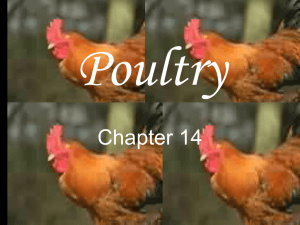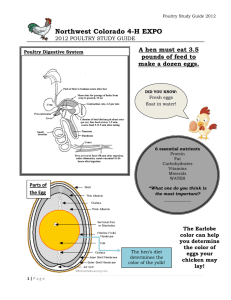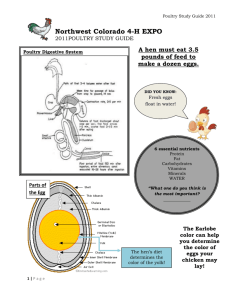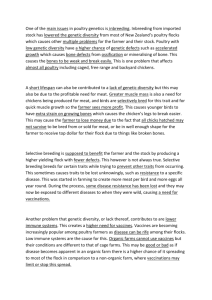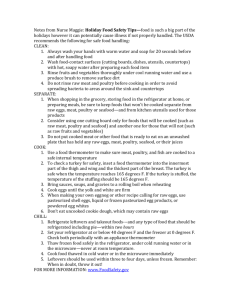LESSON A2ñ3:
advertisement
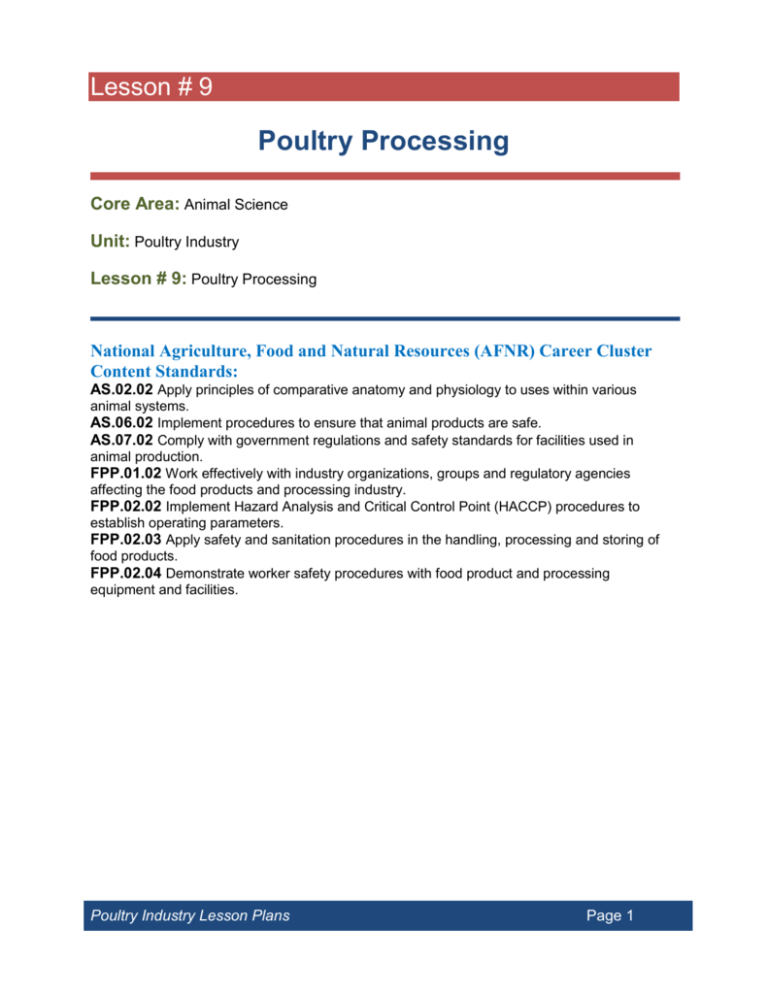
Lesson # 9 Poultry Processing Core Area: Animal Science Unit: Poultry Industry Lesson # 9: Poultry Processing National Agriculture, Food and Natural Resources (AFNR) Career Cluster Content Standards: AS.02.02 Apply principles of comparative anatomy and physiology to uses within various animal systems. AS.06.02 Implement procedures to ensure that animal products are safe. AS.07.02 Comply with government regulations and safety standards for facilities used in animal production. FPP.01.02 Work effectively with industry organizations, groups and regulatory agencies affecting the food products and processing industry. FPP.02.02 Implement Hazard Analysis and Critical Control Point (HACCP) procedures to establish operating parameters. FPP.02.03 Apply safety and sanitation procedures in the handling, processing and storing of food products. FPP.02.04 Demonstrate worker safety procedures with food product and processing equipment and facilities. Poultry Industry Lesson Plans Page 1 Student Learning Objectives. Instruction in this lesson should result in students achieving the following objectives: 1. To understand the steps of poultry meat processing. 2. To identify and understand the functions of the equipment used in poultry meat processing. 3. To identify the requirements of packaging labels. List of Equipment, Tools, Supplies, and Facilities. Copies of student handouts o Handout 1. Chicken Anatomy o Handout 2. Chicken Cuts of Meat Copies of student worksheets Terms. The following terms are presented in this lesson (shown in bold italics): Evisceration Preen Gland Microbes Anatomy. The students should understand the anatomy of the bird before approaching this lesson. See Handout 1. Interest Approach. Use an interest approach that will prepare the students for the lesson. Discuss with students their level of familiarity with the conversion of muscle into meat as it deals with the processing of meat. After discussing their familiarity with how meat is produced, introduce this lesson and explain the importance of understanding where and how poultry meat is produced. Poultry Industry Lesson Plans Page 2 SUMMARY OF CONTENT AND TEACHING STRATEGIES Objective 1: To understand the steps of poultry meat processing. Anticipated Problem: What are the steps of poultry meat processing? A. Shackling 1. Poultry meat processing is initiated by hanging, or shackling, the birds to a processing line. 2. Birds are transferred from coops or transport cages to a dark room where they are hung upside down from shackles attached to an automated line. B. Stunning 1. Electrical stunning delivers a current through a water bath to deem the bird unconscious. For a complete stun, birds must receive a particular electric exposure for a specified time. An effective stun will cause the bird to arch the neck, hold the wings tightly to the body, and sometimes have body tremors. The current should be compliant with minimum recommended current / bird. 2. Controlled environment stunning is another alternative stunning process. Birds are immersed in an approved gas or mixture of gases (i.e., CO2) in order to displace oxygen and render the bird unconscious. C. Bleeding 1. After stunning, the birds are passed through an automated knife that makes an incision on the neck to cut the jugular vein. 2. With the carcass hanging upside down and the jugular vein cut, the majority of the blood in the carcass will exit. D. Scalding 1. Scalding loosens the feathers to facilitate their removal. 2. Carcasses are submerged into the scalder that contains water heated to 150 F. 3. This high water temperature serves to loosen the connection of feathers to the skin. E. Picking 1. Picking is a term that refers to feather removal. 2. The picker removes the feathers on the carcass. 3. The picker is an automated machine that contains rubber finger-like projections that rotate in a circular motion to remove feathers without damaging the carcass. F. Removal of feet, head, neck, and oil glands 1. Feet are removed at the knee joints. 2. The head is cut and removed. 3. The neck is cut with machine and esophagus is exposed. Poultry Industry Lesson Plans Page 3 G. Evisceration 1. Evisceration refers to the removal of internal organs. 2. The inedible viscera consists of the spleen, esophagus, lungs, intestines, and reproductive organs. 3. The intestines (viscera) are federally inspected for signs of disease or other problems. i. Identified disease or other problems results in the removal, or condemnation, of the carcass from the processing line. 4. The edible viscera, or giblets, consist of the heart, liver, and gizzard. i. The giblets are packaged in the carcass or sold separately. H. Washing the carcass 1. The carcasses are cleaned for microbial and visible concerns. When processing chicken, microbial bacteria such as E.Coli and Salmonella are analyzed. I. Chilling 1. The carcass temperature must be reduced to prevent microbial growth. 2. The USDA specifies the amount of chilling for specific bird sizes i. 4 lb broiler: 40 F within 4 hours ii. 4-8 lb broiler: 40 F within 6 hours iii. >8 lb broiler: 40 F within 8 hours 3. Submerging the carcass in an ice (chilled water) bath is the most common method of carcass chilling. 4. Carcass can also be chilled by air chilling. i. Air chilling occurs by passing cold air over the carcass. This is a more expensive process but some consumers are willing to pay more for air chilling. J. Cut-up and deboning 1. On average, 75-80% of the live animal weight is retained in the carcass. i. This amount of live weight retained in the carcass is known as the dressing percentage. 2. The carcass can be sold whole, or individual components of carcass can be cut-up for individual sale. i. Cut-up often times includes removal of the breast, thigh, drumstick, and wings. 3. Deboning refers to the removal of bone from the cut-up meat. i. Breasts and thighs are commonly deboned. K. Further processing. 1. The whole carcass or cut-up and deboned pieces may be further processed for added value. 2. Further processing may include forming, curing, smoking, and cooking of products. i. Forming product requires a change in particle size and often includes the addition of ingredients to add flavor. ii. Forming product also requires the use of a mold to obtain desired shape. iii. Formed products include hot dogs, chicken nuggets, or sausage. Poultry Industry Lesson Plans Page 4 3. Curing involves the addition of preservatives, often nitrates, to the meat to improve flavor and product shelf-life. 4. Smoking also acts as a preservative while providing additional flavor to the product. 5. Some product may be prepared in a form that is edible without additional preparation and is known as “ready-to-eat”. L. Storage 1. Poultry meat should be refrigerated at approximately 30 F. Keeping the poultry below 40 F reduces the risk of microbial growth. 2. Refrigeration and freezing does not kill all microbes, some will survive. Objective 2: To identify and know the functions of the equipment used in poultry processing. Anticipated Problem: What equipment is used during processing? I. Stunning Cabinet a. Electrical circuit passes through the whole body and usually delivers about 200mA, depending on the setting. II. Automated Knife Blade a. Cuts the throat and jugular vein allowing the blood to flow out of the bird. All birds are stunned and insensible to pain prior to entering the automated knife machine. III. Scalding Tank a. The purpose is to loosen the feather follicles of the bird so that the picker can remove the feathers. IV. Picker a. Soft, rubber projections (“fingers”) are installed throughout the picker to remove all of the feathers so the bird is ready for processing. V. Pnuematic shears a. An air powered device to remove the neck and head. Objective 3: To understand the layout of a poultry processing facility. Anticipated Problem: How is a poultry processing plant layout organized to ensure the production of a safe food product? I. Flow of operations 1. Poultry processing plants are highly organized and mechanized facilities that contain state-of-the-art technology to ensure the safe preparation of poultry meat products. 2. Processed product should travel from the area of highest potential contamination to the lowest potential contamination. Poultry Industry Lesson Plans Page 5 II. Personnel traffic flow 1. Personnel traffic flow should be restricted to prevent potential contamination of product. 2. Personnel should be restricted to their routine work area. III. Separation of raw and ready-to-eat product 1. Ready-to-eat products must be located in a separate facility from raw product in order to prevent potential contamination. 2. Ventilation systems should direct airflow away from cooked products. Objective 4: Identify the requirements of a packaging label Anticipated Problem: What needs to go on a packaging label. 1. “Sell By” i. Product dating not required. ii. Preferred by stores for dating. iii. Date used for quality assurance. iv. Food can still be used if chicken is frozen and the sell by date is expired. 2. Plant Code i. The plant code traces the facility that produced the product and tracks the product in case of a recall. 3. Grade of Chicken i. Grade A- best quality (plump, bruise free, no broken bones) 4. Nutritional Facts i. Serving sizes ii. Fat, sugar, sodium, and carbohydrate inclusion. 5. “Keep Refrigerated” 6. Following label regulations i. Follow all claims 1. For example: if labeled “Organic”, the bird must have been raised organically and certified organic. ii. Some labels are misleading 1. For example: “No hormones or steroids” – It is illegal to use hormones or steroids in poultry production. Review/Summary. Focus the review of the lesson around the student learning objectives. Ask students to explain the content associated with each objective. Use their responses as the basis for determining any areas that need to be covered again. Application. Application can involve student activity with the provided labs. Sample Lab 1 Attached. Evaluation. Evaluation should focus on student achievement of the objectives for the lesson. Various techniques can be used, such as a written test. A sample test is attached. Poultry Industry Lesson Plans Page 6 Answers to Sample Test: Part One: Matching I G H D J A E C F B 1. Shackling 2. Stunning 3. Bleeding 4. Scalding 5. Picking 6. Evisceration 7. Washing 8. Chilling 9. Deboning 10. Dressing Percentage Part Two: Packaging Details Sell By Plant Code Nutritional Facts Keep Refrigerated Grade of Chicken Part Three: T / F 1. F 10. T 2. T 11. T 3. T 12. T 4. F 13. F 5. T 14. T 6. F 15. F 7. T 16. T 8. T 17. F 9. F 18. F Poultry Industry Lesson Plans Page 7 Handout 1. Chicken Anatomy Poultry Industry Lesson Plans Page 8 Handout 2. Chicken Wholesale Cuts Poultry Industry Lesson Plans Page 9 Handout 3. Processing Flow Delivery of Live Birds Stunning and Slaughter Picking (Feather Removal) Evisceration Trimming and Rinsing Chilling (cold water bath / air chill) Packaging (Whole Bird) Deboning & Cut up Packaging Cold Storage or Distribution Poultry Industry Lesson Plans Cold Storage or Distribution Page 10 Activity. Sample Laboratory Assignment 1 Examine the cutout data of chicken cuts and compare to the cost at a grocery store. Before the lab: Go to the local grocery store and get the prices for the following in price / pound: Whole Chicken Boneless Chicken Breast Chicken Wings Chicken Leg Quarters Using these prices, you are going to compare the cost of buying a whole bird and cutting it up to make chicken breasts, wings, and leg quarters with their price / pound at the grocery store. You will need to purchase one chicken to demonstrate how it is cut down into the chicken wholesale cuts. Show the students how it is more cost effective to buy a whole chicken and process it yourself rather than by the individual cuts. Poultry Industry Lesson Plans Page 11 Activity. Sample Laboratory 2 Grocery Store Meat Department Review Assignment The ways meat products are sold in a Supermarket are of great interest to a meat packer. The space allocated, the packaging, and the type of products presented are directly related to the amount of meat sold. Objective – Visually review a Fresh Meat Case in local supermarket and gather some information regarding pricing, the type of products presented, ingredients used, and marketing strategies. You may want to ask the butcher or meat manager questions. They may answer you questions or they may not. If they are concerned, just tell them you are doing a class project. Be professional. Be respectful. Look at everything. Procedure – Each group of students (3-4) will visit an assigned store in the local area and collect all needed data. Data Collection – Part 1 - Review the entire fresh meat case. Observe the different cuts, different packaging methods, and prices. Gather at least the following information and answer the questions. What type of meat sales case does the store have; full service case, self service case, or both? How long (in feet) is the entire meat case? How many feet are devoted to each type of meat (beef, lamb, pork, and poultry)? Why do you think the proportions differ for each type of meat? Does the store offer any branded poultry products? What types of ground poultry does the store offer? What are the fat percentages offered? What are the prices for the different types of ground poultry products? What types of chicken cuts are available? What is most expensive cut of chicken? What is the least expensive? Does the store offer any point-of-purchase information? Nutritional information? Does the store offer any Natural or Organic Poultry products? How many different brands of poultry hot dogs are sold? What are the three brands with the largest shelf space? Part 2 - You have $16.00 and must buy the ingredients and prepare a meal for 4 students. Decide what you would buy, why, how much, how you would prepare it, and how much it will cost. The meal must be balanced and contain a starch, a vegetable, and a poultry item. You cannot use ground poultry. Part 3 - During your review of the meat case, examine all fresh meat items. Each member of the group should be prepared to discuss one unique aspect of the visit. Presentation – After you have visited the store and collected data, as a group, you are required to prepare a presentation reporting your findings. This summary/presentation can be prepared using PowerPoint. Explain what you found and your general impressions. Be prepared to present your information during the following week. Each member of the group is required to participate. Poultry Industry Lesson Plans Page 12


